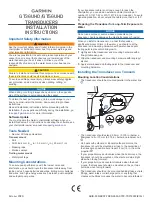
65-2330RKSS H
2
S Transmitter • 21
5. Turn the regulator knob clockwise to close the regulator.
6. Unscrew the regulator from the zero air calibration cylinder.
7. Leave the sample tubing connected to the regulator and the calibration cup.
Setting the Response Reading
1. Verify that the calibration gas is representative of the transmitter’s target gas.
2. For toxic gas cylinders (like H
2
S), it is important to vent the regulator while installing it
onto the cylinder. Venting the regulator during installation helps prevent air from getting
into the cylinder and degrading the gas. Open the regulator by turning the knob
counterclockwise and then install it onto the cylinder.
3. Allow the gas to flow for two minutes, then verify that the reading matches the response
reading (± 2mV) you determined earlier. If necessary, use the span pot on the amplifier to
adjust the reading to match the correct response reading.
4. Turn the regulator knob clockwise to close the regulator.
5. Unscrew the regulator from the calibration cylinder.
Returning to Normal Operation
1. Remove the voltmeter leads from the amplifier test points.
2. Unscrew the calibration cup from the detector.
NOTE:
For convenience, leave the components of the calibration kit connected by the sample
tubing.
3. Secure the junction box cover to the junction box.
4. When the display reading falls below the alarm setpoints, return the controller to normal
operation.
5. Verify that the controller display reading decreases and stabilizes at 0 ppm.
6. Store the components of the calibration kit in a safe and convenient place.


































